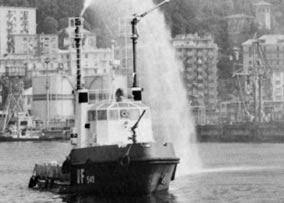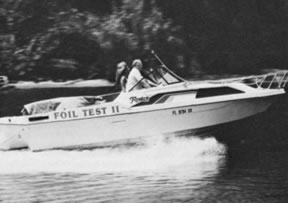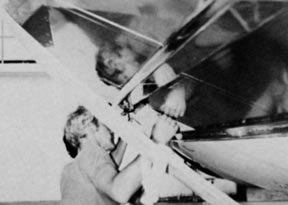From Copper Topics, CDA Inc., Winter 1988
- Italy's New Fire Boats Have Copper-Nickel Hulls
- World's Oldest Copper-Nickel Hull
- Top Foil Supplier Is Perma-Foil International
- Two Copper-Nickel Hulls Associated with U.K.
- Copper-Nickel Foil From English Boat Builder
- First Copper-Nickel Hull Served in World War Two
- CDA's Pioneering Success With Copper-Nickel Hulls
There are now dozens of anti-fouling copper-nickel hulled boats around the world—one more than 20 years old—and the unanimous agreement of their owners, operators, and other experts is that these hulls remain virtually free of fouling and corrosion.
This means for these boats a uniquely low maintenance, constant speeds, and continuous availability because of lack of downtime and drydocking for hull maintenance.
CDA recently tracked down as many of these copper-nickel protected boats as possible, including the six boats whose construction was spearheaded by CDA itself.
These vessels ranged from work boats, such as CDA's pioneering and highly influential shrimp boats and Italy's new fleet of harbor boats, to luxury yachts.
The boats also ranged in sheathing from 90-10 and 70-30 copper-nickel plate, to thin copper-nickel foil, and are located from Genoa to the China Seas, Ft. Lauderdale, and New York City.
Here is a report on some of these copper-nickel protected boats.

Copper-nickel hulled work boats and pleasure craft around the world, from Genoa (above) to New York, remain virtually free of fouling, a CDA survey shows. The copper-nickel hulled Romano Rosati seen here, with its "water cannons" blazing, is one of what soon will be 11 fire boats protecting Italy's harbors.

On the market for more than a year now, hull-protecting, copper-nickel foil was first tested on this fiberglass pleasure boat, owned by Perma-Foil International Inc., Ft. Lauderdale, leading supplier of hull-protecting, copper-nickel foil systems.
Italy's New Fire Boats Have Copper-Nickel Hulls
Most if not all of Italy's new harbor fire boats will have copper-nickel hulls to eliminate biofouling for top speeds and continuous availability in the event of danger—two essential advantages not delivered by conventionally-hulled vessels because of speed-inhibiting barnacles and frequent downtime due to hull cleaning.
Four of the copper-nickel hulled fire boats (called "battello antin-cendio") have been in service long enough to document through official testing the anti-fouling properties of copper nickel. Seven more harbor boats, in the current series of copper-nickel hulled vessels, are now under construction, and should be launched in 1988.
The four copper-nickel hulled Italian fire boats now in service, with a record of faultless periodic hull inspections, include the:
- Sabatino Bocchetto (No. 541), the first copper-nickel hulled Italian fire boat, now at work in Naples,
- Romano Rosati (No. 542), now in service in Genoa, the Mediterranean's biggest petroleum storage harbor and therefore a number-one fire danger,
- Aldo Filipippini (No. 543), currently protecting the harbor at Ancona, and a
- Yet unamed fire boat (No. 544), now at work in Syracuse, Sicily.
In addition to the well-known economies of copper-nickel hulls, such as virtually no hull maintenance and downtime, plus reduced fuel consumption, the copper-nickel hulls on the Italian fire boats also mean continuous availability in the event of fire emergency in the harbor.
"These are emergency boats, never more than one or two per harbor, so when they are needed, they are needed," declares Dr. Ruggero Revelli, director of the Instituto Italian Del Rame, Milan, one of the organizations responsible for getting the copper-nickel hulls on the new Italian fire boats.
"With the biofouling characteristic of conventionally-hulled boats, there is always uncertainty as to the availability of a boat, plus the additional uncertainty as to just how fast that boat can move at any one time. This is absolutely unacceptable in emergency vessels such as harbor fire boats when there is an alternative," continues Dr. Revelli.
According to Sebastiano Guglielmo, commander in charge of fire protection for the Genoa harbor, the new copper-nickel hulled boat is inspected every two weeks, and its hull remains "completely clean."
World's Oldest Copper-Nickel Hull
The world's oldest copper-nickel hulled boat—a 52-foot vessel which also has a solid copper-nickel frame—is still sailing, and has remained free of biofouling and corrosion throughout more than two decades of service.
Named the Asperida and currently docked in New York's Staten Island just off Manhattan, the sporty ketch motor-sailer is owned and skippered by Paul Dent, a self-taught sailor and partner in a New York City construction firm specializing in remodeling commercial spaces.
Mr. Dent purchased the then 14-year-old sail boat from a San Diego judge who told him how the copper-nickel hull came to be.
The boat was built by an Alabama college professor and engineer—Dr. Kenneth Coons—in search of the "ultimate hull."
For years, the professor had tested in seawater all possible hull materials—ferro cement, wood, aluminum, steel, fiberglass—finally to decide that the clear winner was copper-nickel. He then had the boat built in Holland, with both the hull and the frame of 70-30 copper nickel.
"In all the years I've had the boat, I've never had to scrape or, of course, paint the hull. Not only is that an enormous saving—such hull maintenance can cost up to $3,000 a year—but all the other promised advantages came true as well: maintenance of initial speeds, fuel economy, and total availability of the boat," declares Mr. Dent.
Top Foil Supplier Is Perma-Foil International
Undoubtedly the leading supplier of hull-protecting copper-nickel foil systems is Perma-Foil International Inc., Ft. Lauderdale.
The pressure-sensitive, adhesively-bonded copper-nickel foil, introduced for commerical applications in South Florida in 1986, will soon be available nationally through a network of selected marinas, reports Perma-Foil president Graham C. Andoe.
The present product—tailor-made for fiberglass (today's major hull material) plus wood—will be joined shortly by additional copper-nickel ahesive products for aluminum and steel hulls, ranging from pleasure craft to large work vessels.
In addition to the present pressure-sensitive 5.5 mils or .0055 of an inch foil, Perma-Foil International has or will soon be adding the following products:
- New adhesive systems so that all hull materials can be fully protected,
- A 10-mil copper-nickel foil for charter and commercial boats, or for pleasure boats with aluminum and steel hulls,
- A new corrosion control system to protect non-copper-nickel elements on the boat,
- A new line of through-hull fittings and appendages, plus
- A new edge sealant that is flexible, water-proof, and impact resistant.
In addition, Perma-Foil International has made its seven-year warranty transferable when the boat is sold.
Two Copper-Nickel Hulls Associated with U.K.
The copper-nickel hulled boats most associated with the United Kingdom are the Sieglinde-Marie and the Pretty Penny, reports the International Copper Research Association's office outside London. INCRA has developed much welding technology for copper-nickel hulls.
Launched in 1978, the Sieglinde-Marie is a motor sailer 21 meters long, or slightly more than 68 feet, with a hull incorporating 90-10 copper-nickel, six millimeters thick or .224 of an inch. This particular vessel is the first in the United Kingdom to have a 90-10 copper-nickel hull—the first any where being CDA's Copper Mariner shrimp boat launched in 1971.
The Pretty Penny, launched one year later, is a sailing yacht ten meters long,—about 33 feet, with a hull protected by 90-10 copper-nickel, in this instance, three millimeters thick, or about .112 of an inch.
Copper-Nickel Foil From English Boat Builder
Another type of copper-nickel hulled boat associated with the United Kingdom are those pleasure craft sheathed by Britisher Fred Mitchell, who applies copper-nickel foil to the hull for protection.
Mr. Mitchell described himself as the "only person applying a copper-nickel, anti-fouling sheathing guaranteed to stop hull marine growth for 25 years." With this anti-fouling guarantee, he also promises "dramatically improved sailing."
First Copper-Nickel Hull Served in World War Two

The Asperida, the world's oldest copper-nickel hulled boat at more than 20 years, is seen having its hull inspected this Summer. Verdict: Virtually free of fouling.
The very first copper-nickel hulled boat was undoubtedly the Revere, a 45-foot yacht cruiser launched in 1942, by Revere Copper & Brass, Inc., and then drafted into World War II service with the U.S. Navy and Coast Guard.
Described at the time as one of the fastest cruising yachts of her size, the Revere attained speeds of 35 miles an hour. This high speed was attributed both to an innovative hull design, and to the drag-free properties of its copper-nickel hull.
The hull, deck, and superstructure of the Revere were made of copper-nickel sheets, about l½ inches thick. This was the same material that Revere had used in making condenser tube for naval and merchant vessels for many years—a material that had become legendary for its "almost perfect resistance to saltwater pitting and corrosion," a World War II report on the Revere said.
CDA's Pioneering Success With Copper-Nickel Hulls
As is clearly evident in the many technical papers on copper-nickel protected boats built after CDA's pioneering shrimp boats—papers which credit these boats as providing a highly influential breakthrough— CDA's carefully documented success with copper-nickel has lead the way to a new generation of such boats.
Here is a brief review of these CDA copper-nickel hulled boats.
Copper Mariner
Launched in 1971, more than 16 years ago, the Copper Mariner is a 67-foot shrimp boat with a hull incorporating welded panels of 90-10 copper-nickel on a steel framework.
Still sailing off the coast of Nicaragua at last report, the Copper Mariner has never had to have its hull scraped due to biofouling, nor ever experienced hull corrosion, according to its owners.
In all tests on record, the Copper Mariner has maintained consistently the greater speeds and reduced fuel consumption delivered initially by the copper-nickel hull.
With its hull of 90% copper and 10% nickel (Copper Alloy No. 706), this prototype shrimper was conceived as a cooperative effort by CDA, INCO, and IMESA, Mexico's largest builder of commercial fishing vessels at the time.
Copper-Nickel Hulled Fleet
The world's first copper-nickel hulled shrimping fleet—four trawlers built and launched at Salina Cruz in Mexico—was completed in 1974.
The 52-foot shrimp boats were designed with copper-nickel hulls to achieve four months' extra fishing time each and every year because of no downtime due to the usual hull maintenance.
The copper-nickel hulled boats were built for Ocean Foods & Trades (C. & J.) Ltd., Sri Lanka, a major fishing firm and exporter, by Astilleros IMESA, S.A. They were later transferred to Uranus Industries in Hong Kong.
Copper Mariner II

Undoubtedly the leading supplier of hull-protecting copper-nickel foil systems is Perma-Foil International, Ft. Lauderdale, which more than a year ago introduced a hand-applied, copper-nickel foil for wood and fiberglass pleasure craft.
Launched in 1983, the 76-foot shrimp boat Copper Mariner II currently is in service off the Western Coast of Mexico.
Built in Salina Cruz, Mexico, its hull incorporates composite 90-10 copper-nickel plate, .078 inch thick, metallurgically bonded to steel.
According to its owner, the copper-nickel hull always has remained free of fouling and corrosion.
